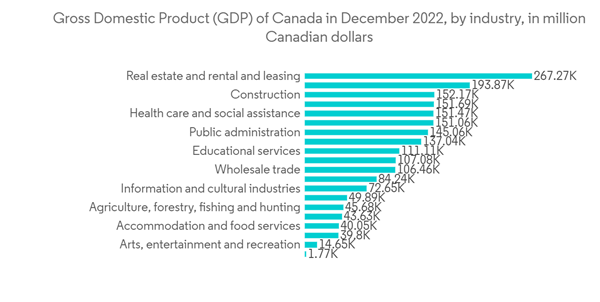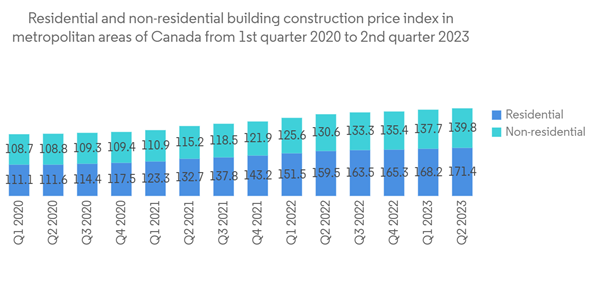Key Highlights
- In the second quarter of 2022, RBC's aggregate affordability metric reached a new high (60.0%) nationally, as well as in Victoria (67.6%), Vancouver (90.2%), and Toronto (83.0%). Smaller markets in Ontario (including Hamilton, London, St. Catharines, Kitchener-Waterloo-Cambridge, and Windsor) and British Columbia (including Kelowna) also attained their lowest levels of affordability in history, based on the mortgage carrying cost to family income ratio.
- Ottawa (RBC composite affordability of 48.5%) and Halifax (41.3%) reached previous highs. While the situation isn't as bad in other parts of the country - in fact, many markets in Alberta and Saskatchewan, as well as some in Atlantic Canada, appear to be decently priced - the rapidly deteriorating trend is widespread. A spike in RBC's indicator indicates a lack of affordability.
- Higher mortgage rates have yet to have their full impact. Further expected, Bank of Canada rate hikes will put additional upward pressure on ownership expenses in the second half of 2022. Buying a typical property in Canada costs an extra USD 380 per month in the second quarter (or 5.9% of household income), with higher mortgage rates accounting for USD 230 (3.5 percentage points). Buyers in Vancouver (up 8.1 percentage points as a share of income), Toronto (up 8.1 percentage points), Victoria (up 6.7 percentage points), and Ottawa and Halifax (both up 4.8 percentage points) saw the greatest increases.
- According to the Canadian Real Estate Association, the average selling price of a home sold on the MLS system in April 2022 was USD 716,000. This is the fourth monthly gain in a row, with a total increase of more than USD 100,000 since the beginning of the year.
- Much of the bounce is due to an increase in sales in the Greater Toronto Area and British Columbia's Lower Mainland, two areas of the country that experienced both the greatest gains during the early days of COVID-19 and the greatest decline once interest rates rose.
- When those two areas are excluded, the national average price falls by more than USD 144,000 to an average house price of USD 572,000 in cities other than Toronto and Vancouver.
Canada Real Estate Services Market Trends
Increasing Contribution to GDP from the Real Estate Sector to Provide Opportunities
According to the analysis, the massive magnitude of anticipated immigration will result in higher real GDP growth at the national level and across all Canadian provinces. Higher levels of immigration can be mitigated by an increase in the number of dwellings created across Canada, regardless of where newcomers choose to live. According to the Desjardins analysis, the number of home starts across Canada would have to climb by about 50% immediately and remain at that level until 2024 to counteract the price increase induced by the boom in immigration.Last quarter, Canadian home investment contributed less to GDP. In 2022, the segment accounted for 8.7% of GDP, a 1.1-point decrease from the previous quarter and a 1.5-point decrease from the last year.
Simultaneously, residential investment increased by 4.3%, a 1.3-point increase over the same period. In other words, residential investment expanded at a rate five times that of GDP. Residential investment accounted for a sizable portion of growth in the previous quarter. GDP increased by USD16.1 billion in 2022, with residential investment growth accounting for approximately 43% of the increase.
Since 2005, RERL has increased 20% faster than GDP on average. It is still a small percentage of real estate's contribution to Canada's GDP. Prior to the pandemic, Canada used its real estate to inflate its GDP estimates. Now, it is using it to boost the economy's recovery, making it even more reliant.
Increase in Residential Investment
The housing-related part of the gross domestic product (GDP) is known as residential investment. It comprises the cost of building a home, major improvements, and the transfer of ownership. Because other industries, such as finance, are reliant on housing, the metric needs to be more comprehensive. However, it is the largest direct contributor to GDP from housing investment. Residential investment in Canada has been absorbing an increasing amount of the economy.There are numerous variables driving the rising attention on sustainability and the real estate business, as well as other aspects of environmental, social, and governance (ESG) performance, but a few challenges stand out. One of the most important is the ability to attract funds. Companies with a good ESG track record will have an edge in recruiting investment from institutional players and sourcing new types of funding that continue to grow in Canada at a time when financing is both less available and more expensive.
Canadian real estate corporations have responded by increasing their focus on ESG strategies, and expectations in critical areas, such as having solid commitments to address climate change, continue to climb. However, while real estate firms may expect increased investor concerns about their strategies to achieve net-zero greenhouse gas emissions, our interviews revealed that some companies have yet to embrace this new necessity completely. In addition, according to our 2022 worldwide CEO Survey, only 19% of real estate executives claimed their company has committed to net-zero greenhouse gas emissions.
Housing investment declined 3.9% in the first quarter of 2023, the fourth consecutive quarterly decline, as borrowing costs rose and mortgage borrowing slowed. Investment fell across the board, with new construction (-6.0%), renovations (-2.1%), and ownership transfer expenses (-1.5%), which implies resale activity, all down. Except for Yukon, every province and territory had a decrease in new buildings.
Canada Real Estate Services Industry Overview
The market is fragmented, comprising both international and local players. Some prominent international companies in the region include Colliers International Group Inc. and Cushman & Wakefield ULC. The real estate sector is gradually recovering from the pandemic and is expected to grow during the forecast period. The supply crunch is unprecedented in Canada’s housing market, but other factors are expected to influence buying and selling conditions in 2022.Additional Benefits:
- The market estimate (ME) sheet in Excel format
- 3 months of analyst support
This product will be delivered within 2 business days.
Table of Contents
Companies Mentioned (Partial List)
A selection of companies mentioned in this report includes, but is not limited to:
- Colliers International Group Inc.
- Cushman & Wakefield ULC
- FirstService Corporation
- Living Realty Inc.
- Cadillac Fairview Corporation Ltd
- Re/max Realtron Realty Inc.
- SNC-Lavalin Operations & Maintenance Inc.
- Royal LePage Limited
- Triovest Realty Advisors Inc.
- Sutton Group Preferred Realty Inc.*










